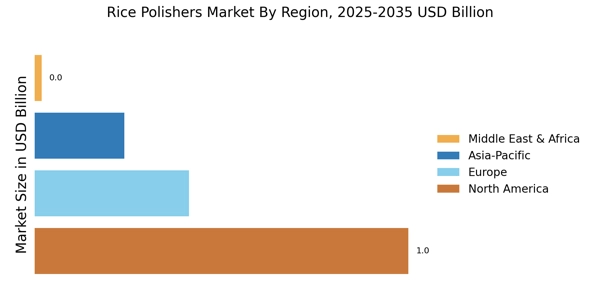The Rice Polishers Market is currently characterized by a dynamic competitive landscape, driven by technological advancements and increasing demand for high-quality rice processing equipment. Key players such as Satake Corporation (Japan), Bühler AG (Switzerland), and Mitsubishi Electric Corporation (Japan) are at the forefront, each adopting distinct strategies to enhance their market presence. Satake Corporation (Japan) focuses on innovation, particularly in developing advanced polishing technologies that improve rice quality and yield. Meanwhile, Bühler AG (Switzerland) emphasizes sustainability, integrating eco-friendly practices into its manufacturing processes, which resonates well with the growing global emphasis on environmental responsibility. Mitsubishi Electric Corporation (Japan) is leveraging digital transformation, enhancing its product offerings with smart technology solutions that optimize operational efficiency. Collectively, these strategies not only bolster their competitive positioning but also shape the market dynamics by setting higher standards for product quality and operational efficiency.
In terms of business tactics, companies are increasingly localizing manufacturing to reduce costs and enhance supply chain resilience. This approach appears to be particularly effective in regions with high rice production, allowing for quicker response times to market demands. The Rice Polishers Market is moderately fragmented, with several players vying for market share. However, the influence of major companies is substantial, as they often set industry benchmarks in terms of technology and sustainability practices, thereby shaping the competitive structure.
In August 2025, Satake Corporation (Japan) announced the launch of a new line of energy-efficient rice polishers designed to reduce energy consumption by up to 30%. This strategic move not only aligns with global sustainability trends but also positions Satake as a leader in eco-friendly rice processing technology. The introduction of these machines is likely to attract environmentally conscious customers, enhancing Satake's market share in a competitive landscape.
In September 2025, Bühler AG (Switzerland) entered into a partnership with a leading agricultural technology firm to develop AI-driven solutions for rice processing. This collaboration aims to integrate machine learning algorithms into rice polishing operations, thereby improving efficiency and reducing waste. Such a strategic alliance underscores Bühler's commitment to innovation and positions it favorably against competitors who may not yet be leveraging AI technologies in their operations.
In July 2025, Mitsubishi Electric Corporation (Japan) unveiled a new smart rice polisher equipped with IoT capabilities, allowing for real-time monitoring and data analytics. This development is significant as it reflects the growing trend towards digitalization in the agricultural sector. By offering enhanced connectivity and operational insights, Mitsubishi Electric is likely to attract tech-savvy customers looking for advanced solutions in rice processing.
As of October 2025, the Rice Polishers Market is witnessing trends that emphasize digitalization, sustainability, and the integration of artificial intelligence. Strategic alliances are increasingly shaping the competitive landscape, enabling companies to pool resources and expertise to drive innovation. Looking ahead, it is anticipated that competitive differentiation will evolve, with a shift from traditional price-based competition to a focus on technological advancements, sustainability, and supply chain reliability. This transition suggests that companies that prioritize innovation and operational excellence will likely emerge as leaders in the market.


















Leave a Comment